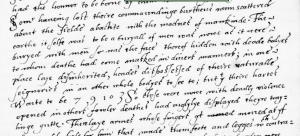I have not yet made a complete review of the literature on the topic, but it seems likely that the Cambridge Manuscript of Sidney’s New Arcadia, Cambridge University Library MS Kk 1.5, features a previously undocumented variant in one of Sidney’s greatest and goriest descriptions of battle. Sidney’s catalogue of soldiers’ bodies mutilated in Basilius’ siege of Amphialus’ castle in book three, on f. 165r, mentions “heads dispossessed of their natural seignories… [and] bodies to see to, but that their hearts, wont to be bound all over so close, were now with deadly violence opened” (The Countess of Pembroke’s Arcadia, ed. Victor Skretkowicz [Oxford, Clarendon Press, 1987], 340-41). The Cambridge manuscript omits “bound over” and replaces it with the Arabic numerals 7, 9, 10, and 3. Below I include a transcription and a screenshot of the passage in question. I’d love to hear from anyone who has an idea about this oddity.
Som haueing lost theire commaundinge burthens rann scattered
about the fielde abashte with the madnes of mankinde. The
earthe it selfe was to be a buryall of men was nowe as it were
buryed with men so was the face thereof hidden with deade bodyes
to whom deathe had come masked in diuers manners; in one
place laye disinherited, heades dispossessed of theire naturalle
seignories in an other whole bodyes to see to; but that theire hartes
Wonte to be 7 9 10 3 So close were nowe with deadly violence
opened in others fowler deathes had ouglylye displayed theyre tray:
linge guttes.

